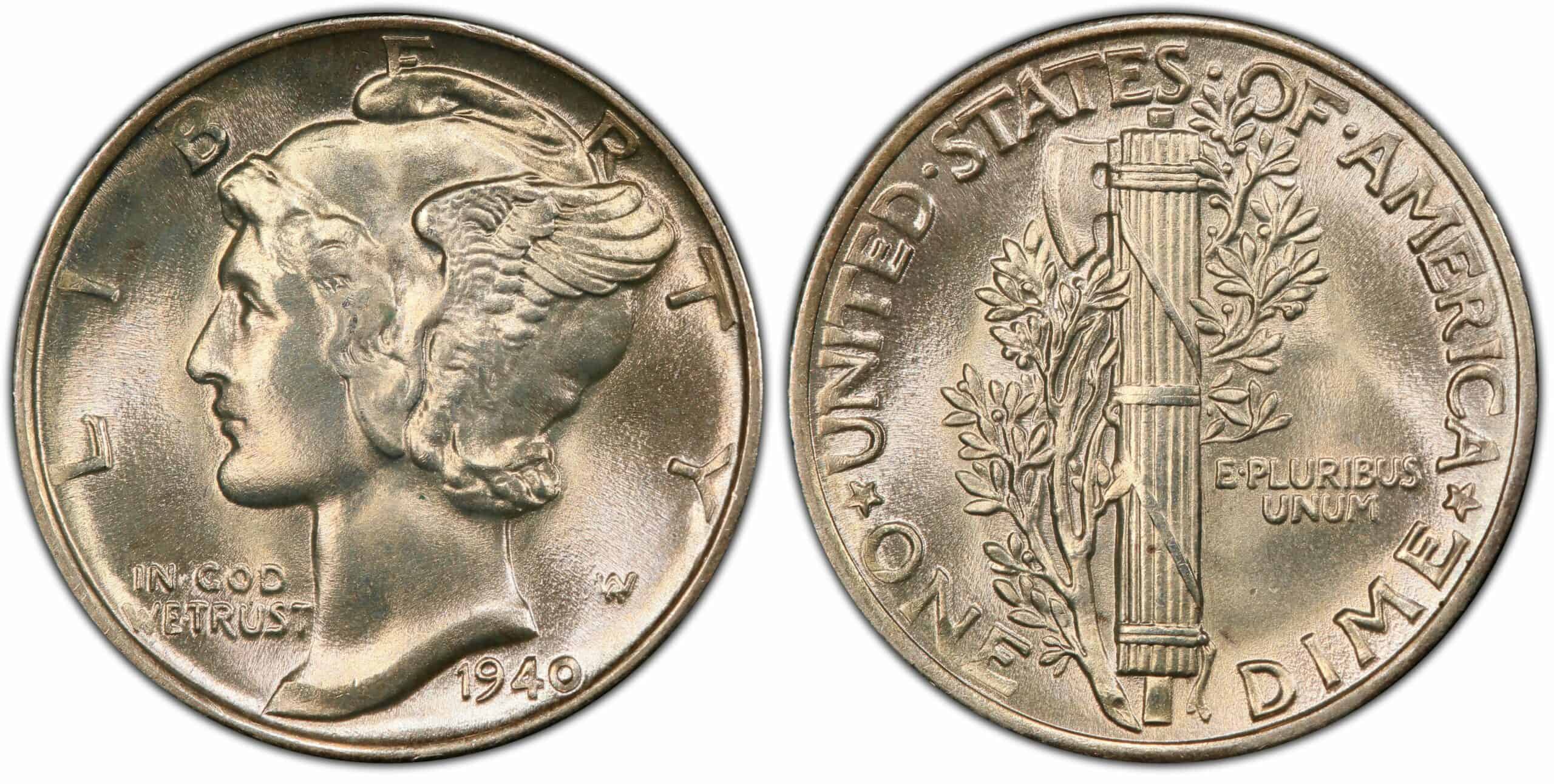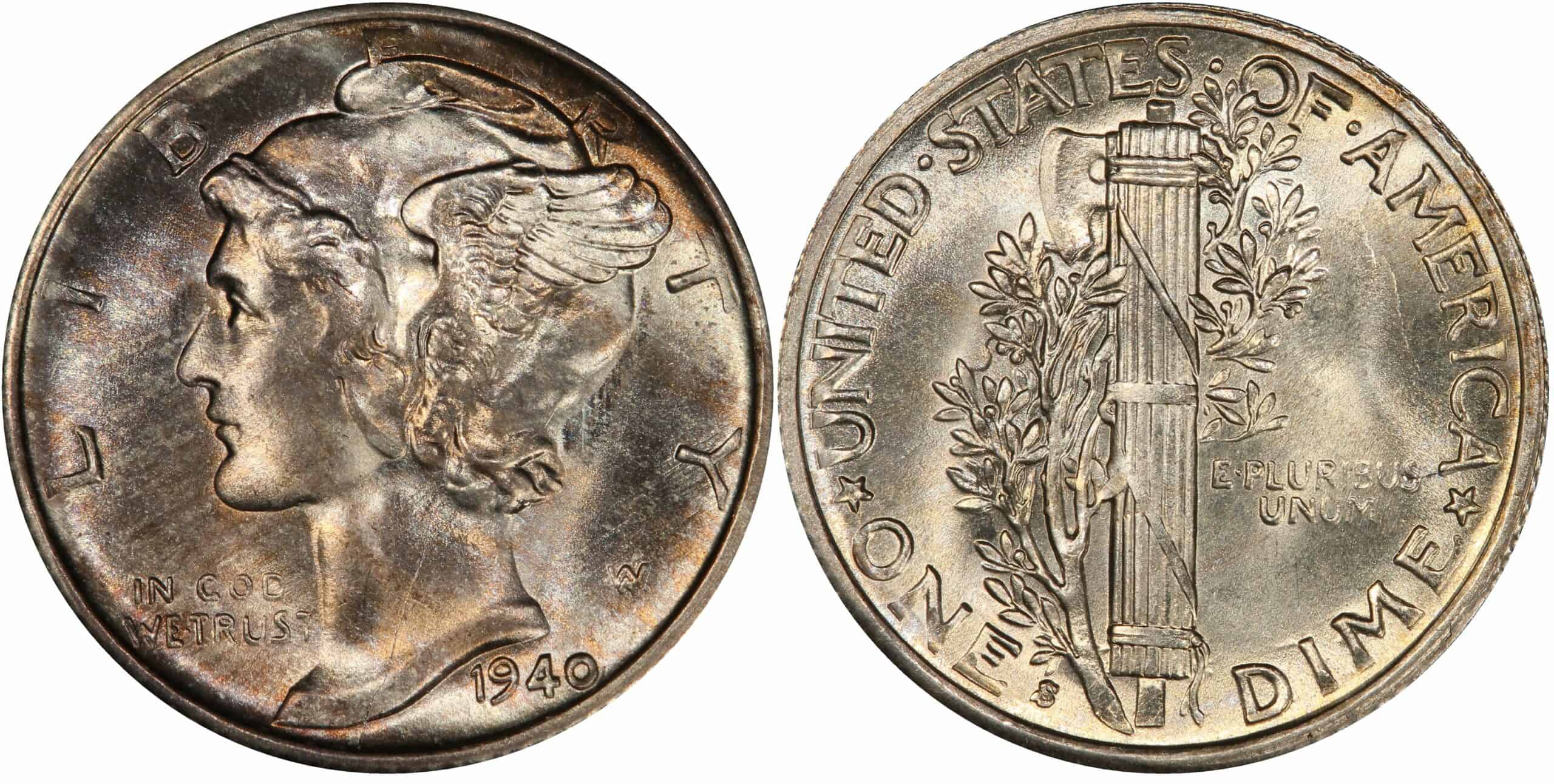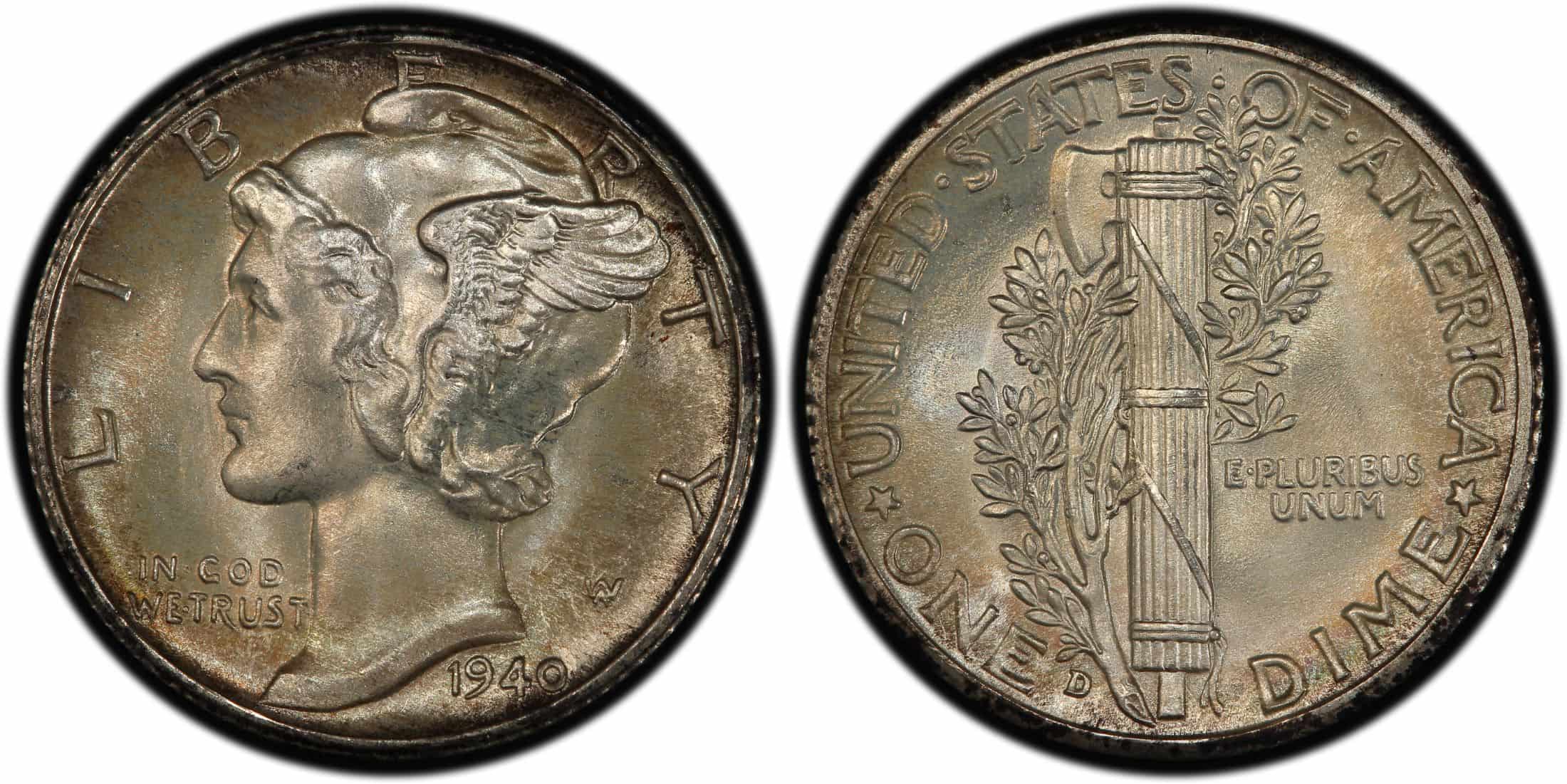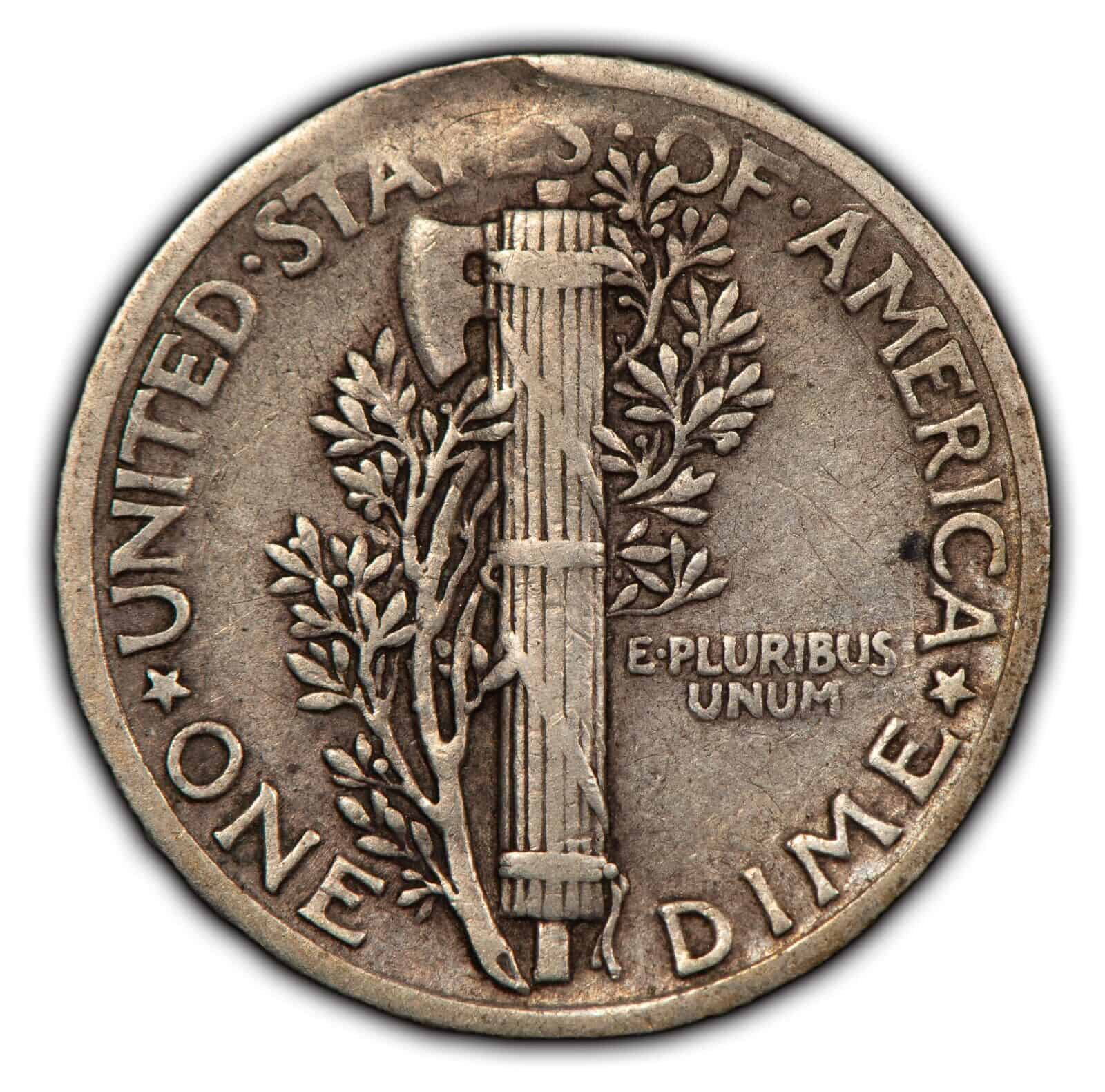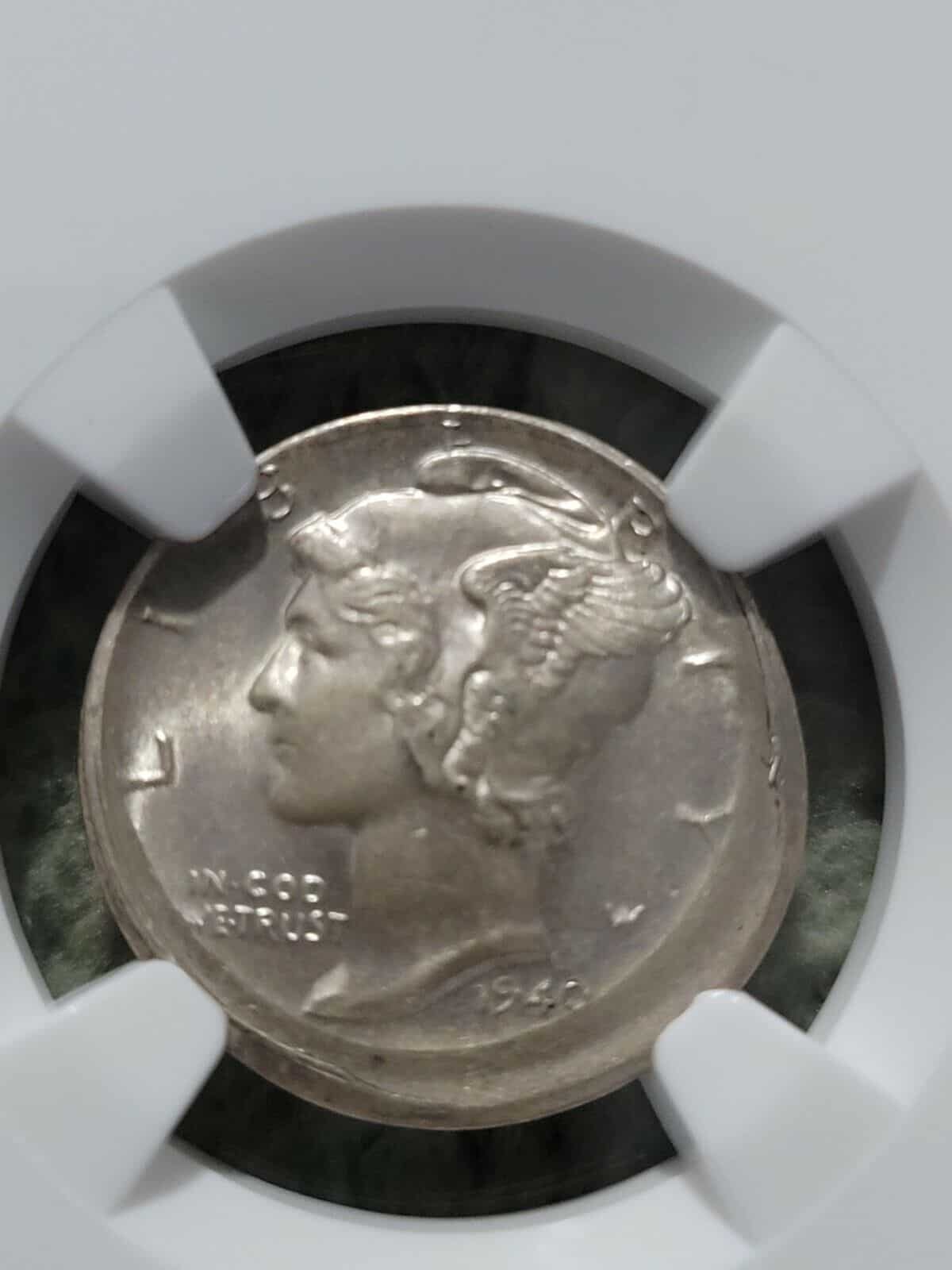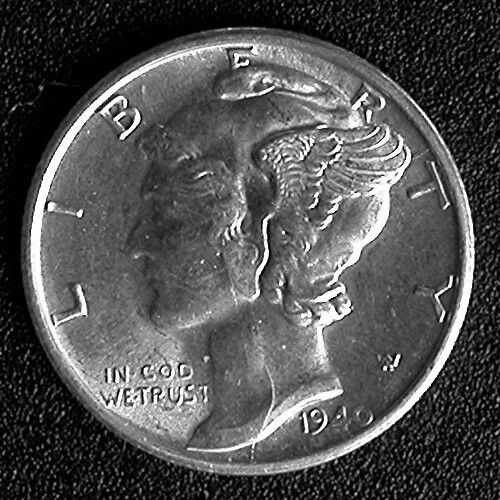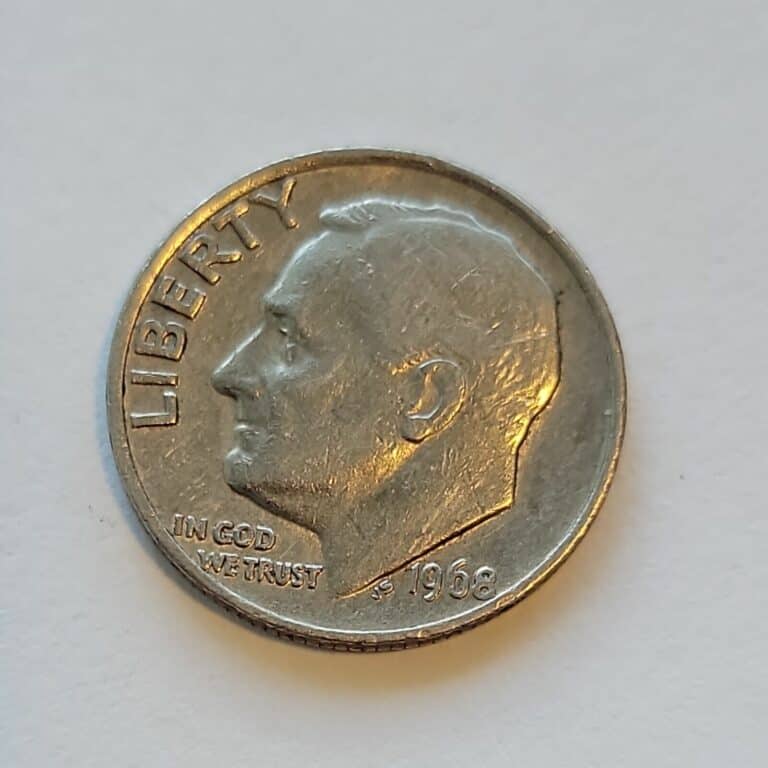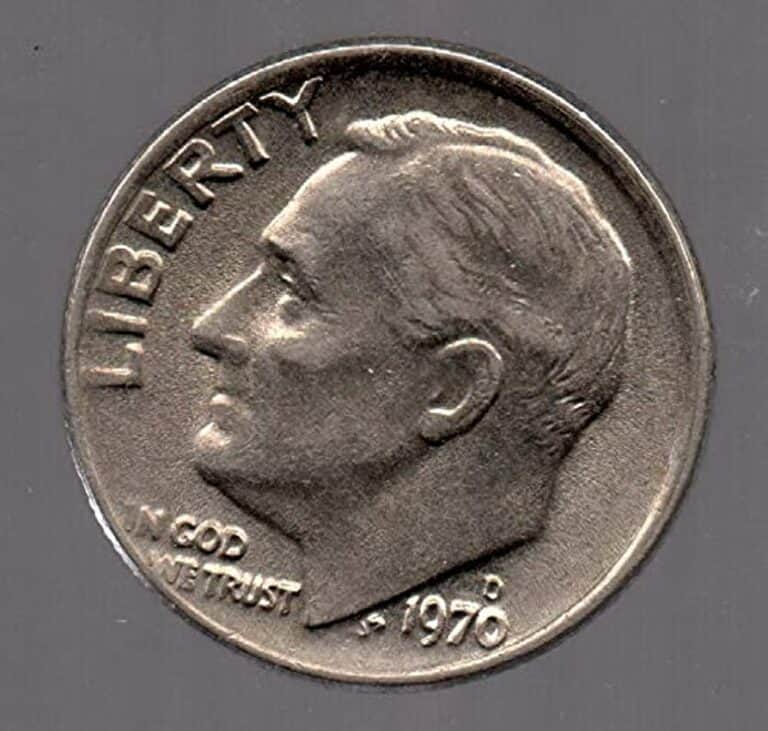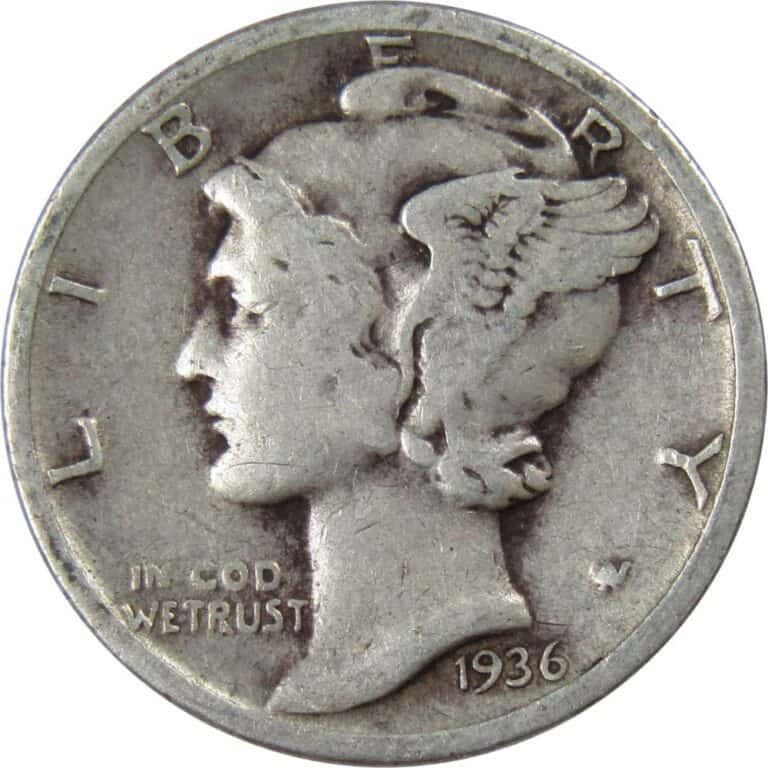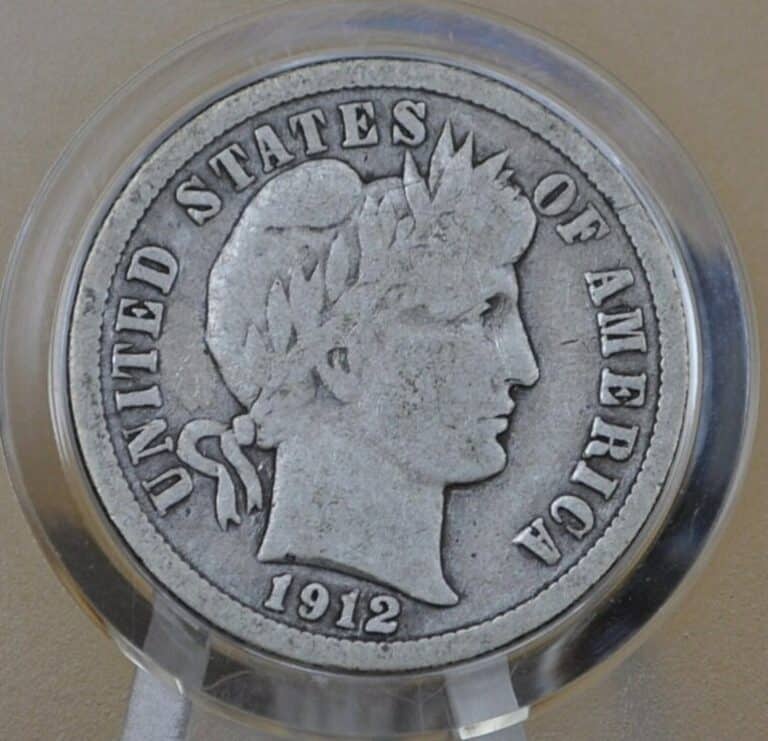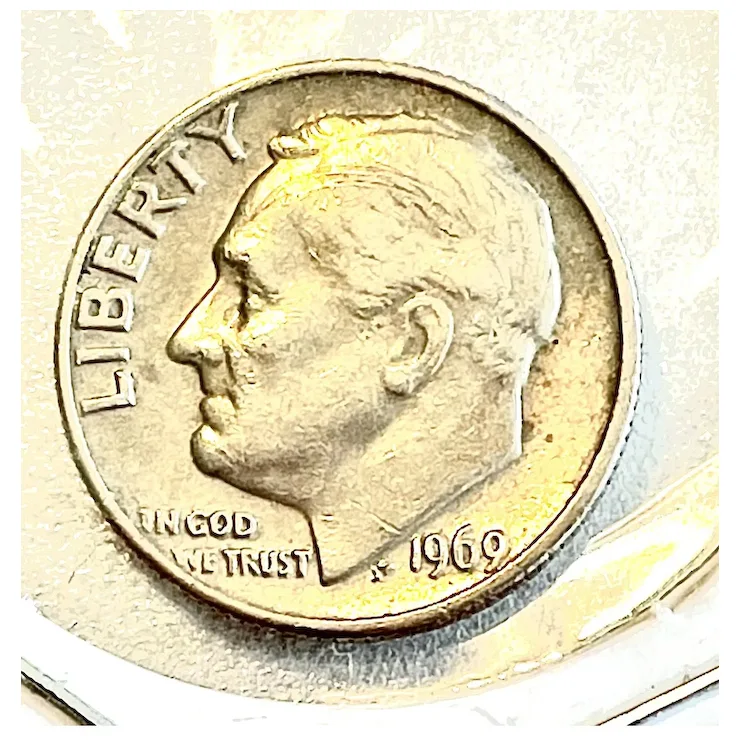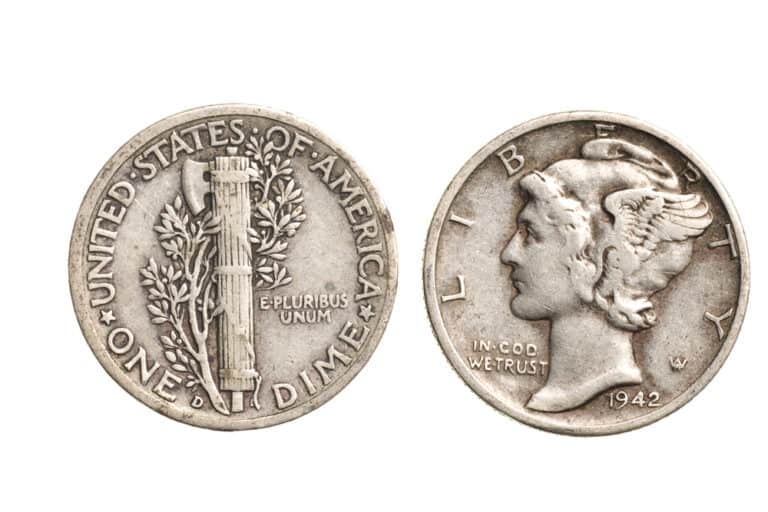1940 Dime Value: How Much Is It Worth Today?
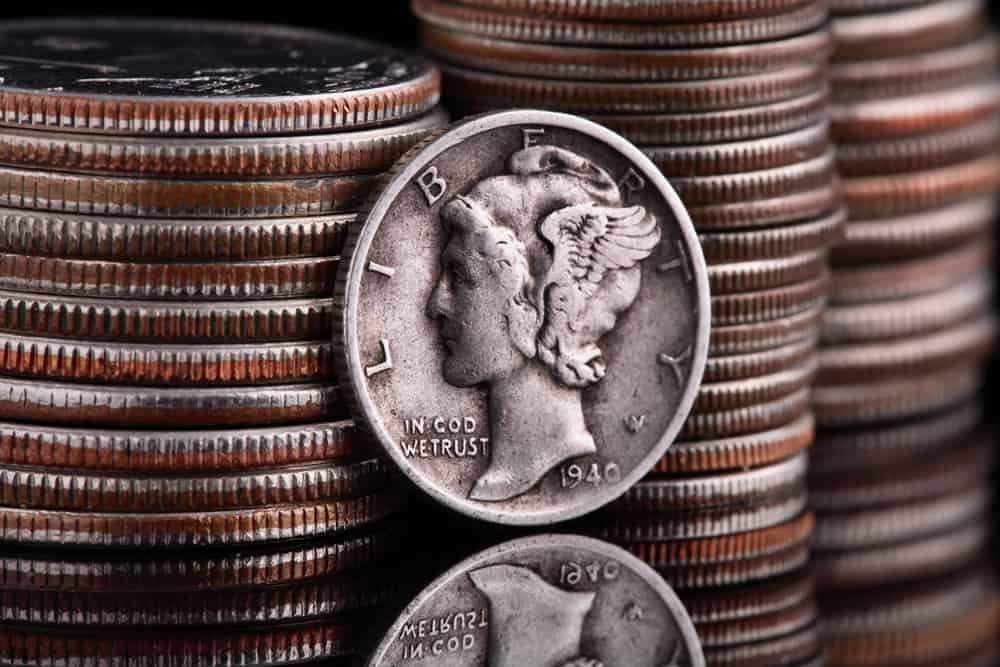
If you’ve been collecting dimes for a while, it‘s natural to wonder about the 1940 dime value. After all, many collectors find this coin interesting. Fortunately, we’re here to provide you with all the information you need.
Here, we are going to do a deep dive into the history of these coins, their price, and the factors that affect this price.
1940 Dime Value Chart |
||||||
| Type | XF45 | AU55 | MS63 | MS66 | MS68 | PR69 |
| 1940 No Mint Mark Dime (P) Value | $5 | $6 | $22 | $55 | $500 | $48,500 |
| 1940 D Dime Value | $5 | $6 | $22 | $55 | $1,200 | _ |
| 1940 S Dime Value | $5 | $6 | $22 | $55 | $1,750 | _ |
1940 No Mint Mark Dime (P) Value
1940 dimes are part of the Mercury dime series. It succeeded the Barber dime and preceded the Roosevelt silver dime. The Barber dime was minted from 1892 to 1916.
Before it, the mint produced the Seated Liberty dime (1837 to 1891) that succeeded the Capped bust dime (1809 to 1837) that succeeded the Draped bust dime (1796 to 1807).
While these three dimes got their names from their designs, the Barber dime got its name from its designer. He was the mint’s chief engraver at the time, Charles Barber.
Whatever the case, the Mercury dime was minted for circulation from 1916 to 1945.
Also known as the Winged Liberty Head dime, this dime was brought back once in 2016.
The mint did this to celebrate 100 years since the dime’s launch. The special versions minted this year were made of 99.99% gold and had a diameter of 16.5mm. They were sold on the US mint’s website and sold out in a short time.
Keep in mind that the rest of the coins in the Mercury dime series have a diameter of 17.9mm. More importantly, they are made of 90% silver and 10% copper, giving them a mass of 2.5 grams each.
Whatever the case, this dime gets both its names from the image that’s on its obverse. It features young Lady Liberty’s head and neck. In it, she is facing left and is wearing a winged Phrygian cap.
It’s said that the cap symbolizes freedom and liberty while the wings symbolize freedom of thought. Either way, the image makes some confuse Liberty for the Greek god Hermes who is also known as the Roman Mercury. But this isn’t the only thing on the obverse.
It has a “LIBERTY” engraving that runs along the coin’s rim from the left to the right.
The words “IN GOD WE TRUST” also appear under Liberty’s chin and the date is just below where the right side of her neck cuts off.
Beyond that, the initials AW appear a little above the date, to the right of her neck. These are the initials of the man who made the design, Adolph Alexander Weinman. He also made the Mercury dime’s reverse design.
This design features centrally placed fasces with an olive branch surrounding it. While the former symbolizes strength and unity, the latter symbolizes peace. This design also has the legend “UNITED STATES OF AMERICA ” running from left to right along the coin’s rim.
There’s a star before and after this phrase and dots separating the individual words. Another legend on the reverse is “ONE DOLLAR”. It appears along the bottom rim. The two words are separated by the fasces’ and olive branch’s bottom bases.
Both this and the obverse design remained unchanged throughout the period that the Mercury dime was minted. As such, all the dimes minted in 1940 bore these designs. The Philadelphia mint produced most of them.
These were around 65.35 million regular-strike pieces and 11,827 proofs. None of them had a mint mark and many are still available today. Numismatic experts estimate that 50,000 of the former exist across all grades, 10,000 of which are mint-state samples.
These usually sell for $4 to $9 in circulated condition and $10 to $500 in uncirculated condition. Keep in mind that Full Band versions exist as well and they are rarer.
After all, these are mint-state coins whose fasces image has a central band that’s clearly separated. Only 12,000 of these coins still exist and they usually go for $15 to $35,250.
Interestingly, 1940 proof dimes are even rarer than these Full Band coins. It’s estimated that only 10,000 proof versions still exist and 9,950 of them have a grade of PR60 or better.
The circulated samples sell for $40 to $100 each while the uncirculated ones sell for $120 to $48,500. Cameo samples are rarer and more expensive. While a PR67 costs around $525, a PR67CAM fetches $9,500.
1940 S Dime Value
The San Francisco mint produced the second-largest mintage of 1940 dimes. These were 21.56 million pieces. All of them were regular-strike coins and had an S mint mark.
This mark is located on the coin’s reverse side, between the word “ONE” and the olive branch’s base. Expert estimates suggest that 40,000 of these coins still exist, and only 8,000 of them are mint-state samples.
Only half of these have a grade of MS65 or better. While the circulated samples go for $1 to $9 each, the uncirculated ones sell for $10 to $8,500 per piece. Full Band samples are even rarer; only 6,000 still exist. One sells for $25 to $15,000.
Interestingly, the 1940 S dime has other die varieties that also have Full Band versions. One variety is the Double Die Obverse (DDO) and Double Die Reverse (DDR) FS-901 variety. This one shows doubling on the obverse and/or reverse details.
Circulated samples in this variety usually cost $10 to $55. Mint-state samples go for $60 to $500. Full Band samples cost more; a sample sells for at least $70.
Another 1940 S dime variety is the S/S RPM FS-501. This features a Repunched Mint Mark (RPM) error. This looks like a mint mark that appears twice, one on top of the other. A G4 sample sells for $14 while an AU58 one sells for $33.
On the other hand, uncirculated samples sell for from $37 to over $2,000 per piece. Full Band samples start from $70 per piece.
1940 D Dime Value
The Denver mint produced 21.198 million 1940 D dimes. These were all regular-strike coins and had a D mint mark on their reverse side. This mint mark is located between the word “ONE” and the olive branch’s base.
Numismatic experts estimate that around 30,000 of these coins still exist across all grades. 4,000 of these are estimated to be in mint state and half of those have a grade of MS65 or better.
A circulated sample fetches $4 to $9 while an uncirculated one fetches $10 to $1,200. On the other hand, Full Band versions sell for $20 to $5,250 per piece. A Full Band Prooflike piece usually goes for thousands of dollars.
However, keep in mind that these aren’t the only dimes that were minted in Denver. Several Mercury dimes have been minted here too.
Even some of the Roosevelt dimes that are still minted to date have been produced at the Denver mint. All these coins have the image of Theodore Roosevelt on their obverse. In it, he is facing left.
1940 Dime Grading
Grading 1940 dimes and other Mercury dimes requires looking at their surfaces and trying to identify any wear. The less wear the coin shows, the higher the grade it will be assigned. Remember, the most pristine coins are referred to as uncirculated or mint-state samples.
These have a grade of 60 to 70 on a scale that runs from 1 to 70. The samples that have a grade of 1 to 59 are known as circulated coins. These can be grouped into categories like good, very good, fine, extremely fine, and about uncirculated.
Generally, mint-state samples are more expensive than uncirculated samples.
Rare 1940 Dime Error Lists
1940 D Dime Repunched Mint Mark (RPM)
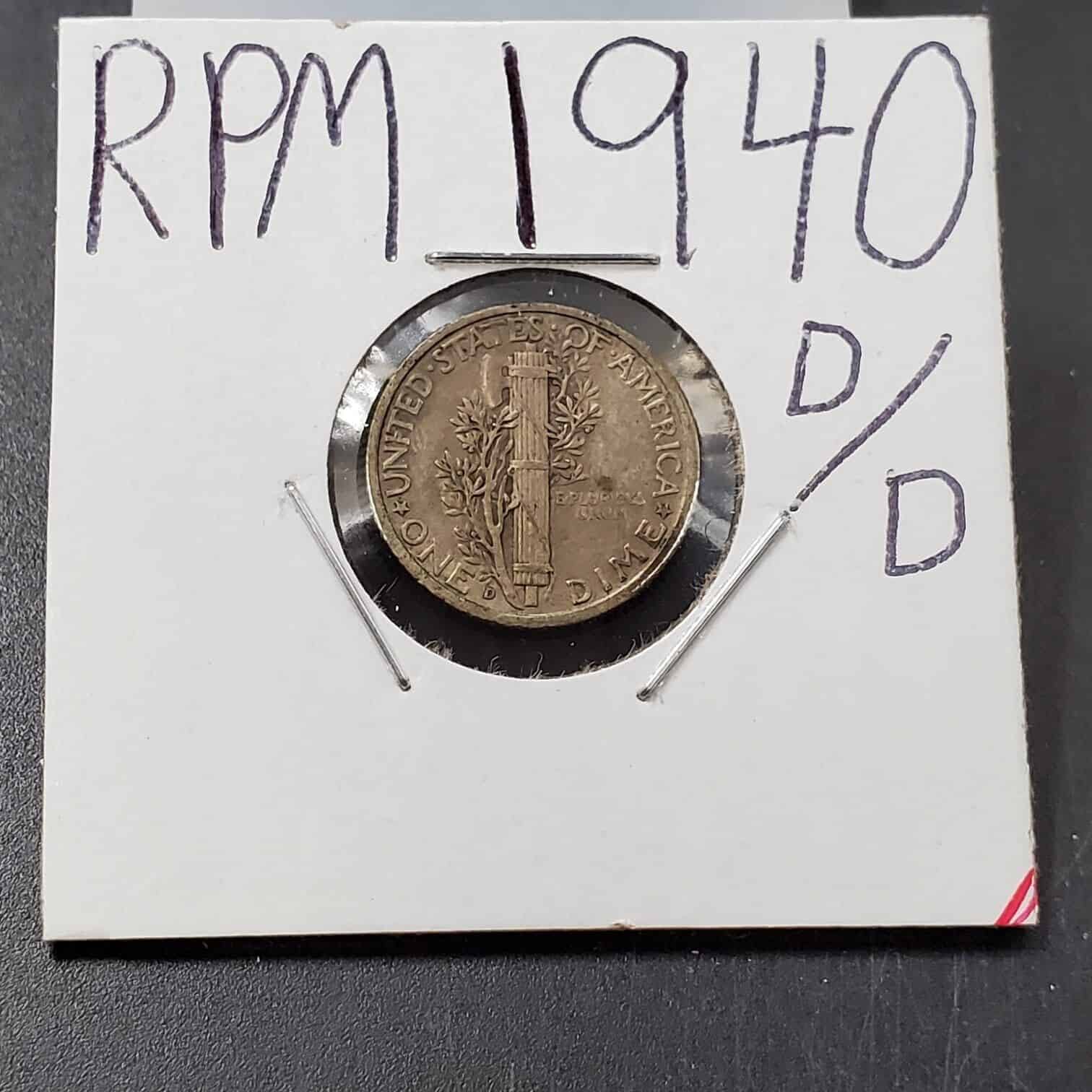
Sometimes, a 1940 D dime has a mint mark that has been punched more than once. This is called a Repunched Mint Mark (RPM) error. It makes you see some doubling when you look at the mint mark.
A 1940 D dime with this error usually sells for around $25.
1940 Dime Clipped Planchet
A clipped planchet error occurs when a blank is incorrectly punched. An ungraded 1940 dime with this error sells for around $17 on eBay.
1940 Dime Broad Struck Off-center
A broad-struck error occurs when a coin is struck outside the collar. This creates a coin that’s more spread out than it should be. Sometimes, this coin is also struck off-center, making the coin even more valuable.
An NGC MS61 Full Band 1940 S dime that’s broad-struck off-center can sell for around $400 on eBay.
1940 Dime Die Crack
As its name suggests, a die crack is an error that occurs when a die cracks. This can happen because of the pressure that it goes through during the minting process. Once a die cracks, every coin it strikes develops a bump where the coin metal enters the crack.
A 1940 S dime with two of these bumps can sell for around $34 on eBay.
1940 Dime FAQ
How much silver is in a 1940 Mercury Dime?
A 1940 Mercury dime is made of 90% silver. This translates to 0.0723 troy or 2.248 grams of silver.
How can you tell if a dime has silver?
To check whether a dime has silver, look at its edge. If this has a bold silver stripe, the dime is made of silver. Copper-clad coins will usually have a bold copper stripe.
Is a dime worth more than a penny?
A dime has a face value of 10 cents while a penny has a face value of 1 cent. On the other hand, a nickel has a face value of 5 cents. As such, a dime is usually more valuable than a penny or nickel.
However, if you have a dime from the past, it can cost less than a penny or nickel from the same year or another one. Ultimately, the present value of an old dime or penny depends on its mintage, mint mark, variety, errors, and date.
What year are dimes all silver?
The only dimes that are made of 100% silver are special Roosevelt proofs that have been minted since 2019. These are sold to collectors in silver proof sets. From 1992 to 2018, these sets contained proofs with 90% silver and 10% copper.
This is also the composition of all business strike dimes minted before 1965. Since 1965, the mint has been using a composition of 91.67% copper and 8.33% nickel. To achieve this, the mint clad a pure copper core with a layer of 75% copper and 25% nickel.
What dime is worth 1.9 million dollars?
The 1894-S Barber dime sold for $1.9 million in 2007. Another sold for $1.3 million before this. Ultimately, this is one of the rarest United States dimes.
Who pays the most for old coins?
Major auction houses pay the most for old coins that are rare and special. These institutions present your coins to a global audience, allowing you to get the best price possible.
But before you take your coin to an auction house, you will need to send it to a professional grading company like NGC or PCGS. While this will cost you a fee, you won’t need to worry about any high seller and delivery fees.
If the coin you have is in bad condition and doesn’t seem to be valuable, it’s best to just sell it at a local coin shop, dealer, show, or online store. Whatever you do though, don’t sell your coins to pawn shops, jewelry stores, and random buyers.
These usually offer low prices and some may even be scammers.
